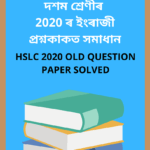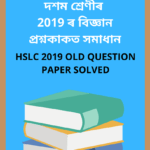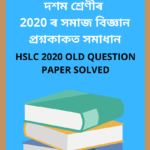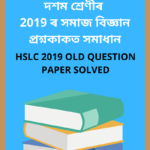SEBA Class 10 History Question Paper Solved 2023 English Medium, SEBA Class 10 History Question Paper Solved PDF Download, HSLC 2023 History Question Paper Solved 2023 to each Paper is Assam Board Exam in the list of SEBA so that you can easily browse through different subjects and select needs one. Assam Board HSLC 2023 History Previous Years Question Paper Solved can be of great value to excel in the examination.
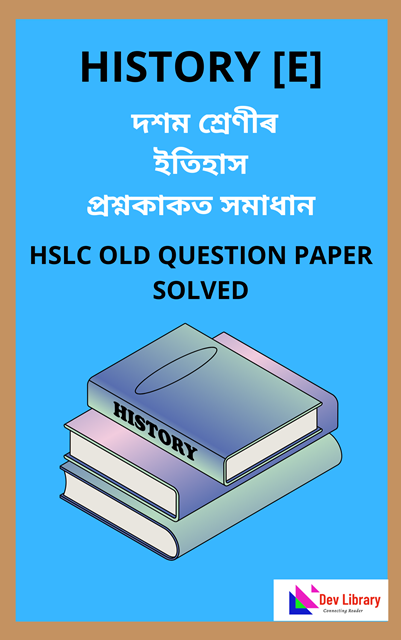
SEBA Class 10 History Question Paper Solved 2023
HSLC Old Question Paper provided is as per the 2023 Assam Board Exam and covers all the questions from the SEBA HSLC 2023 Question Paper. Access the detailed SEBA Class 10 History Old Question Paper Solved provided here and get a good grip on the subject. Access the HSLC 2023 History Old Question Paper Solved, Class X History 2023 Old Paper Question Answer of English in Page Format. Make use of them during your practice and score well in the exams.
HISTORY (E)
2023
HISTORY (E) OLD PAPER
ALL QUESTION ANSWER
1. Choose the correct answer:
(a) Which country was called the ‘workshop of the world’?
(i) England.
(ii) America.
(iii) Russia.
(iv) France.
Ans: (i) England.
(b) In the Versailles Peace Conference, Italy was represented by —
(i) Clemenceau.
(ii) Lloyd George.
(iii) Orlando.
(iv) Sir Douglas Haig.
Ans: (iii) Orlando.
(c) The second World War ended in the year –
(i) 1945
(ii) 1946
(iii) 1947
(iv) 1948
Ans: (i) 1945
(d) The country which is called the ‘Gift of Nile’ is —
(i) Sri Lanka.
(ii) Indonesia.
(iii) Namibia.
(iv) Egypt.
Ans: (iv) Egypt.
(e) The first summit meeting of the Non-Aligned Movement was held in Yugoslavia in the year—
(i) 1961
(ii) 1962
(iii) 1963
(iv) 1964
Ans: (i) 1961
2. Who discovered the sea-route from Europe to India?
Ans: Vasco da Gama, a Portuguese traveller, was the first to discover the sea route to India.
3. ‘Diplomacy without force is like music without instruments.’ — Who said?
Ans: ‘Diplomacy without force is like music without instruments,’ said Frederick the Great.
4. What is the new name of Formosa?
Ans: The new name of Formosa is Taiwan.
5. What is the Present name of ‘Gold Coast’?
Ans: Ghana is the present name of ‘Gold Coast’.
6. In which year did the ‘Warsaw Pact’ originate?
Ans: ‘Warsaw Pact’ was originated on 14 may 1955.
7. Write the name of two Portuguese settlements in the Western Coast of India.
Ans: The two Portuguese settlements in the West Coast of India are Goa and Daman.
8. Write the name of two members of the Central Powers.
Ans: The two members of the Central Power Alliance are Germany and Austria.
9. Who set fire to the German Parliament and when?
Ans: The German Parliament building was set on fire on February 27, 1933 by Lubbe.
10. What is ‘War Communism’?
Ans: War communism, or military communism, was the economic and political system in Soviet Russia during the Russian Civil War from 1918 to 1921. War communism began in June 1918, enforced by the Supreme Economic Council known as the Vesenkha.
11. Between whom was the ‘Atlantic Charter’ signed?
Ans: The Atlantic Charter was a joint declaration released by U.S. President Franklin D. Roosevelt and British Prime Minister Winston Churchill on August 14, 1941 following a meeting of the two heads of government in Newfoundland.
12. Name the largest and last conference held among the nations with a view to forming the United Nations Organization. Representatives from how many countries of the world attended this conference?
Ans: The San Francisco Conference is the largest and last conference of the nations of the world convened and united to form the United Nations. A total of 260 delegates from 51 countries participated in the conference.
13. Write any two aims of the U.N.O.
Ans: The two aims of the United Nations are —
(i) To save future generations from the devastation of war.
(ii) To restore confidence in the fundamental human rights of all people, regardless of gender, in all countries of the world, large and small, as these rights have already been repeatedly violated by the horrors of war.
14. Write the name of the first nationalist political organization of Sri Lanka. When it formed?
Ans: The first nationalist political organization in Sri Lanka was called the Ceylon National Congress. It was formed in 1911.
15. (i) What is the full form of ‘SAARC’?
Ans: The full form of ‘SAARC’ is — South Asian Association for Regional Cooperation.
(ii) When and where was the first SAARC Conference held?
Ans: The first SAARC Summit was held in 1985 in Dhaka (Bangladesh).
16. What do you understand by the expression ‘New World’?
Ans: North America and South America together are often called the “New World”. The label came about in the wake of European voyages across the Atlantic Ocean. The Europeans discovered these two continents only in the late 15th century. So, to the Europeans, these lands were new compared to the older civilisations.
17. Mention four terms of the Treaty of Versailles.
Ans: The four terms of the Versailles Treaty were:
(a) Conditions Relating to Territory.
(b) Colonial-territorial conditions.
(c) Military conditions, and
(d) Legal and financial and economic conditions.
18. Mention four characteristics of a Fascist State.
Ans: The four main characteristics of the fascist state are —
(i) Fascism is the opposite of socialism, it prefers dictatorship to socialism.
(ii) Fascism is against punishment.
(iii) Fascism is against free trade.
(iv) Fascism is contrary to freedom of the press. B. Newspapers, newspapers, etc. could not convey fearless and impartial news.
19. Write four aims of Hitler’s attack on Russia.
Ans: The four aims of Hitler’s invasion of Russia were —
(i) Hitler advocated violating the terms of the Versailles Peace Treaty, alleging that it hindered German expansion. He demanded that all Germans be subject to one German state and advocated the expansion of Germany’s territory in view of its growing population. Russia and Northeast Europe were chosen for this expansion.
(ii) Hitler believed in German bloodline theory. He believed that Jan. L. People of Aryan descent. The Aryans are the best of all people, so this great German nation has the right to suppress and rule all nations. This so-called theory of superiority of the German nation intoxicated the unemployed youth of the country.
(iii) With the propagation of this theory of German superiority in Germany, there was continuous propaganda against the Jewish and Slavic peoples and citizens living there. They were said to be the root cause of all adultery and corruption in German society. They were deprived of their citizenship rights and removed from government jobs.
(iv) Hitler promoted the political program of the Nazi Party in detail through the 25-point plan. These included the subordination of all Germans to one state on the basis of the principle of self-determination, the abolition of the Treaties of Versailles and St. Germain, the establishment of colonies for Germany’s growing population, the formation of a national army.
20. Narrate briefly about the resistance movement in Poland.
Ans: On 1 September 1939, Germany invaded Poland. On 27 September, the Germans captured the Polish capital. A few days after Germany invaded Poland, Russia invaded Poland from the east to protect itself and occupied the eastern part. The western part was occupied by Germany. After his victory over Poland, Hitler went on an offensive against Denmark and Norway in April 1970 and Belgium, Luxembourg and the Netherlands in May. Hitler used a total of 800 warships and 250 transport ships to invade Norway. The attack took place from both land and water. At the time, a fascist party was formed in Norway led by a man named Vidkun Quisling, who kept in touch with Hitler. With his help, Hitler easily captured the Nawab and established a puppet government led by Swizzling to establish German domination.
The King of Belgium surrendered to Hitler on 28 May. This incident posed a serious threat to the Allies. The Allies withdrew a total of 338,000 troops from the battlefield between 28 May and 4 June.
After their defeat by Hitler, the heads of the former established governments of Norway, Belgium and the Netherlands fled to England and went to London to form governments in exile for their respective countries.
The Allied defeats against Germany in Poland, Norway, Belgium and the Netherlands, as well as the defeats of England and the Netherlands, brought about a political change in England. On 10 May 1940, Conservative leader Winston Churchill was appointed Prime Minister of the United Cabinet and Labor leader Clement Atty was appointed Deputy Prime Minister. Winston Churchill worked hard to ensure Allied victory in World War II.
21. Narrate briefly about the extent of damages caused by the Second World War.
Ans: The countries suffered greatly economically during World War II.
Historian Carlton Hayes shows that the war cost the United States alone $350 billion. Other countries aced $1,000 billion in monasteries and $1,000 billion in property damage.
The war killed about 22 million people and wounded about 34 million. In addition, the war killed about 20 million civilians worldwide. The United States dropped atomic bombs on Hiroshima and Nagasaki, killing about 320,000 people.
During the war, 1,500,000 civilians were killed worldwide as a result of aerial bombing. The massive civilian deaths in this war show how barbaric the people of the warring countries were and how brutal atrocities were committed against people.
22. Write four important international disputes settled by the UNO.
Ans: The four most important international disputes settled by the United Nations are:
(i) Ideological Differences: Conflicting beliefs, ideologies or political views between different groups or parties within a country can lead to internal strife.
(ii) Ethnic or religious tensions: Differences based on race, religion or cultural identity can contribute to internal conflict when these divisions become a source of competition or discrimination.
(iii) Socioeconomic Inequality: Economic inequality, unequal distribution of wealth, poverty, and lack of opportunity can create grievances and fuel internal strife.
(iv) Political power struggles: Contests for political power or control over government institutions can lead to internal disputes, especially in cases where the political system is unstable or prone to corruption.
23. Write about Palestine Liberation Organisation.
Ans: The Palestinian Liberation Struggle was formed in protest against the creation of the state of Israel. The Palestine Liberation Organization was born in May 1964 in Jordan. Since the creation of the State of Israel, Palestinians and other neighbouring countries have struggled for nearly four decades to re-establish a Palestinian state. The Palestinian Liberation Organization was led by a leader named Yasser Arafat. The Palestinian Liberation Organization tried to gain the support of the world community diplomatically to achieve its goals. In the beginning, the organization was dominated by Tito of the Syrian Al-Fatah group. Other militant groups affiliated with the organization include the Palestinian Liberation Front and Black September. The organization was suspected of involvement in terrorist acts around the world.
The Palestinian Liberation Organization (PLO) guerrilla fighters fled to Syria and Lebanon after the civil war in Jordan. Hezbollah almost attacked Syria and Lebanon because of the presence of the Palestinian Liberation Organization. In 1974, the Palestinian Liberation Organization (PLO) moved its headquarters to Algiers, the capital of Algeria. Since then, the United Nations has recognized the organization as a permanent observer to the United Nations.
24. Write the name of four member countries of NATO.
Ans: The four member states of NATO are —- Belgium, Bulgaria, Canada and Denmark.
25. Write a short note on Truman Doctrine.
Ans: The Truman Doctrine is an American foreign policy that pledges American “support for democracies against authoritarian threats.” The doctrine originated with the primary goal of countering the growth of the Soviet bloc during the Cold War. It was announced to Congress by President Harry S. Truman on March 12, 1947, and further developed on July 4, 1948, when he pledged to oppose the communist rebellions in Greece and Soviet demands from Turkey. More generally, the Truman Doctrine implied American support for other nations threatened by Moscow. It led to the formation of NATO in 1949. Historians often use Truman’s speech to Congress on March 12, 1947 to date the start of the Cold War.
Truman told Congress that “it must be the policy of the United States to support free peoples who are resisting attempted subjugation by armed minorities or by outside pressures (other than the United States).” Truman contended that because totalitarian regimes coerced free peoples, they automatically represented a threat to international peace and the national security of the United States. Truman argued that if Greece and Turkey did not receive the aid, they would inevitably fall out of the United States sphere of influence and into the communist bloc with grave consequences throughout the region.
The Truman Doctrine was informally extended to become the basis of American Cold War policy throughout Europe and around the world. It shifted U.S. policy toward the Soviet Union from a wartime alliance to containment of Soviet expansion, as advocated by diplomat George Kennan. It was distinguished from rollback by implicitly tolerating the previous Soviet takeovers in Eastern Europe.
26. Mention the factors responsible for the growth of imperialism.
Ans: The following are the causes for the rise of Imperialism —
Economic causes: In part, imperialism was a consequence of the Industrial Revolution. Faced with the increase in production and wealth, the colonies became profitable markets for the metropolises where they could sell their production without having to pay customs fees. They were also spaces where they could invest their capital, through the construction of public works, such as railways and ports. In addition, the metropolises colonised those territories rich in natural resources, which offered cheap raw materials for their industries.
Demographic causes: In western countries the population grew intensely in the 19th century. Millions of Europeans migrated to the colonies seeking new opportunities. This lessened the problems of unemployment and social unrest in the metropolises. Improvements in transportation (steamships, rail) made travel easier.
Religious causes: Imperialism was justified in many cases by the desire to Christianize peoples who preserved their own religions. The missionary work of the Catholic and Protestant Church was of great importance: missions were founded in Asia, Africa and Oceania.
Political causes: The powers conquered certain places that were strategic to control important sea and land routes. For example, the United Kingdom considered it essential to dominate Egypt to control the routes between Europe and India. Territorial expansion also served to increase the prestige of a country in the world and strengthen national pride among its population.
Ideological causes: The feeling of superiority of the white race and the ideal of civilising peoples that they considered backward also drove colonial expansion. In the West, during the 19th century, racist ideologies were very powerful. Westerners were convinced that the white race was superior and that this gave them the right to dominate other peoples, whom they believed inferior.
Scientific causes: Scientific curiosity also contributed to the momentum of conquests. In the United Kingdom, France, the United States and Germany geographic societies were created that carried out scientific expeditions around the planet. Once a territory had been explored, the country that had organised the expedition had the right to conquer and exploit it.
27. Narrate briefly the immediate cause of the first World War.
Ans: The immediate causes of World War I are discussed below —
(a) Rivalry between the imperialist countries.
(b) Political events in Europe.
(c) Conclusion of military contracts.
(d) Military conflict in Europe.
The first colonialism and imperialism originated in Europe. The fierce rivalry and conflict between these imperialist countries led to the First World War.
The pioneering attitude of imperialist countries and the tremendous rivalry of the aftermath, the tremendous rivalry between each other and the increase in military powers and military rivalry formed in several disputed countries, the secret political military agreements formed among the multiplied states and the doubt and distrust between the states. , nationalist ideology and the tendency to form nation-states among the oppressed and oppressed minorities, and the resulting expansion of violent nationalism, were the causes of World WarI.
At that time, European countries such as England, France, Italy, Germany, Russia, Belgium and Portugal were in conflict and competition with each other. There were also attempts to establish colonies in Asia, Africa, Latin America, Australia, etc. The United States and Japan gradually became involved in this process of European powers. In other words, colonial conflicts and rivalries between capitalist countries continued in different parts of the world over colonies and colonial interests. This rivalry reached its peak in the late nineteenth century.
A few years before the outbreak of World War I, several secret military agreements were signed between the major powers in Europe. German Prime Minister Bismarck signed one military treaty after another in an effort to make Germany a nation-state. In 1873, he brought the emperors of Germany, Russia and Austria into a treaty through the Tri-Emperor Friendship League. In 1875, when rumours circulated that Germany would invade France and Russia offered to help France, Bismarck signed the Austro-German bilateral treaty with Austria in During the subsequent conflict between Austria and Russia over Bulgaria, Austria was dissatisfied with Bismarck’s side with Russia, and the Alliance of the Triple Emperors collapsed. In 1887, Bismarck signed a bi-insurance treaty with Russia to maintain Russo-German relations. The clever Bismarck then established relations with Italy and urged it to become a member of the Austro-German Bilateral Treaty. In 1882, Italy became a member of the Treaty.
28. Discuss the main features of the foreign policy of Hitler.
Ans: The main features of Hitler’s foreign policy are:
(i) He pulled Germany out of the League of Nations in 1993.
(ii) He integrated Austria and Germany in 1938 under the slogan ‘one people, one empire and one leader’.
(iii) He then captured German-speaking Sudetenland from Czechoslovakia and later the entire country.
29. Briefly narrate the background of the history of liberation movements in Africa.
Ans: The independence and liberation movements of the countries of the African continent were the natural outcome of mass demonstrations in protest against colonial and imperialist exploitation. Many events caused by World Wars I and II, the October Revolution and popular attraction to Marxism in countries Z5, democratic governance in Western countries, individual freedoms, civil rights, etc. had a positive impact on the people of various African countries after the end of World War II. In the early twentieth century, Africa was illuminated by the political independence movement.
World War II was a blessing for the countries defeated by colonialism and imperialism. In addition, nationalist movements in various countries of the world appeared as enemies of imperialism on the model of nationalist ideology and nation-states developed in Europe and at the same time this process continued in African countries. The Indian freedom movement had an impact on African countries and the freedom fighters of most African countries followed the ideals of the Indian freedom fighters. The educated people of Africa were the first to lead the freedom movement. The ideals and teachings of India’s freedom struggle were the guide of the struggling people of Africa. Nelson Mandela, the leader of South Africa’s uncompromising struggle against apartheid white rulers, was often inspired and guided by the ideals of the non-violent political movement of Mahatma Gandhi.
The main driving force behind the independence movements in African countries was the racism introduced by whites against blacks. This policy made people in different countries interested in independence. Libya gained independence in 1951, a few years after World War II, and this inspired other African countries to achieve independence. Overall, the freedom struggle that began in India greatly influenced the liberation struggle in Africa and therefore most of the African countries made desperate efforts to free themselves from colonialism and imperialism. In the 1960s, most African countries gained independence from colonial exploitation.
30. Write about India’s relation with Pakistan.
Ans: The partition of India in 1947 led to the establishment of Pakistan as a new state. India – Pakistan relations have not been sweet from the beginning. Its main issue is Kashmir. The issue of Kashmir was even raised at the United Nations. In 1960, after much effort, the two countries signed the Indus Water Treaty. In 1965, Pakistan invaded India. In 1972, the two countries signed the Shimla Agreement. The agreement helped improve relations between the two countries. Relations between the two countries improved in 1988 when Benazir Bhutto became Prime Minister of Pakistan. In 1999, all efforts failed and the Kargil war broke out. Relations between the two countries have not improved in any way at present.
In the formerly united India and Pakistan, the British sowed seeds of suspicion and enmity between Hindus and Muslims through their policies of partition and rule They united to form Hindustan or India and became enemies of each other. The two countries have come forward to resolve the conflict and establish friendly relations, but the suspicion and conflict between the two countries has not ended. There is still conflict between the two countries over Kashmir, borders and terrorist activities. There are also differences and conflicts between India and Pakistan over water sharing and the Rann and Kachchh borders at Char Creek. However, despite the conflicts, the governments of the two countries have not stopped trying to eradicate these conflicts. It has been more or less successful.
In 1998, India tested a nuclear explosion at Pokhran. Pakistan took this seriously and conducted a nuclear test in the Chagai Hills within a few days. Since then, military relations have been established between India and Pakistan, reducing the possibility of war between the two countries. But the suspicion and conflict between the two countries has not ended. India has been alleging that Pakistani intelligence agencies have been carrying out attacks in northeastern India, especially in Assam, through Nepal and Bangladesh. The Pakistani government, on the other hand, believes the Indian government is causing problems in Sindh and Balochistan provinces.
Or
Write about India’s relation with Bangladesh.
Ans: India Bangladesh Relations are important for both the nations. It plays a significant role in their economy, polity, culture and social aspects. India was the first nation to acknowledge Bangladesh as a distinct and independent state, and the two nations forged diplomatic ties as soon as Bangladesh gained its independence in December 1971. Bangladesh and India are connected on a civilised, cultural, social, and economic level. Many things bind the two nations, including their shared history, cultural heritage, and affinity for music, literature, and the arts.
The history of India-Bangladesh relations is complex and multifaceted. The two countries share a long border and a rich cultural heritage. However, they have also had their share of disputes and disagreements.
The relationship between India and Bangladesh dates back to ancient times. The two regions have been closely linked through trade, culture, and religion for centuries. In the 18th century, the British East India Company took control of both India and Bangladesh. The two regions remained under British rule until 1947 when India and Pakistan gained independence.
Bangladesh was part of Pakistan until 1971 when it won its independence in a bloody war. India played a key role in Bangladesh’s liberation war. It provided military and diplomatic support. Since independence, India and Bangladesh have maintained close relations. However, there have been many challenges in the relationship. This includes border disputes, water sharing, and trade issues.

Hi! my Name is Parimal Roy. I have completed my Bachelor’s degree in Philosophy (B.A.) from Silapathar General College. Currently, I am working as an HR Manager at Dev Library. It is a website that provides study materials for students from Class 3 to 12, including SCERT and NCERT notes. It also offers resources for BA, B.Com, B.Sc, and Computer Science, along with postgraduate notes. Besides study materials, the website has novels, eBooks, health and finance articles, biographies, quotes, and more.


